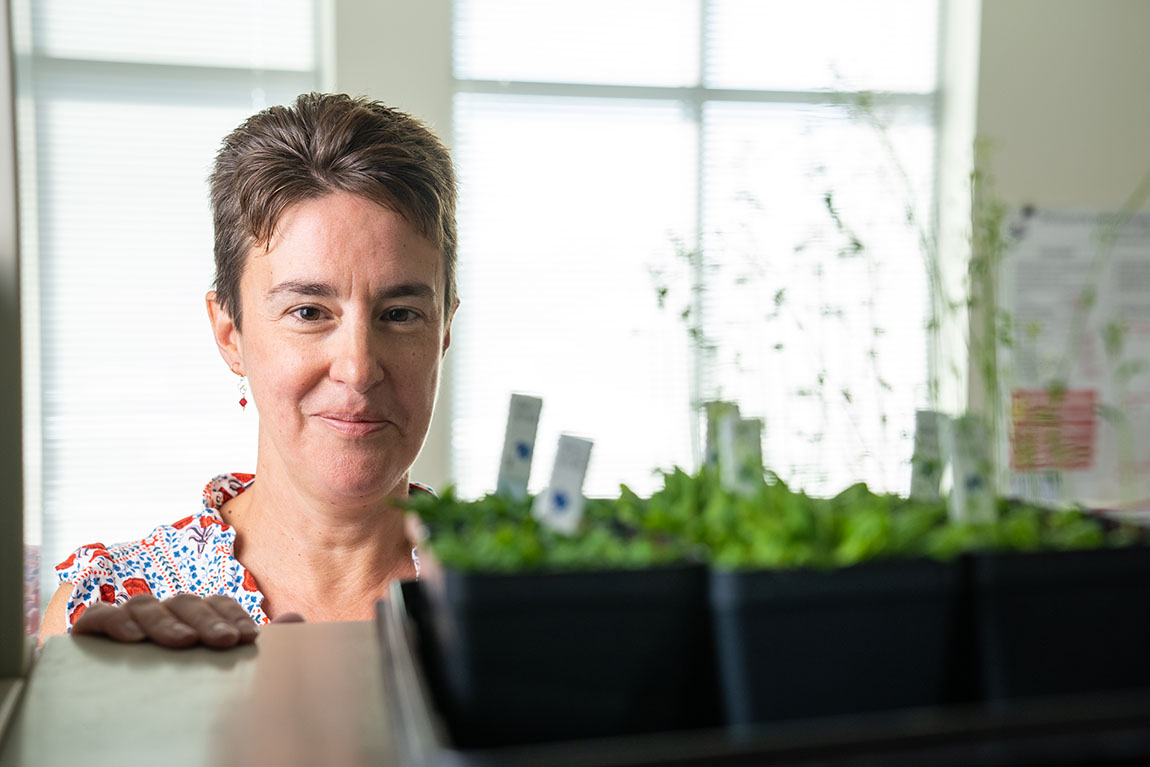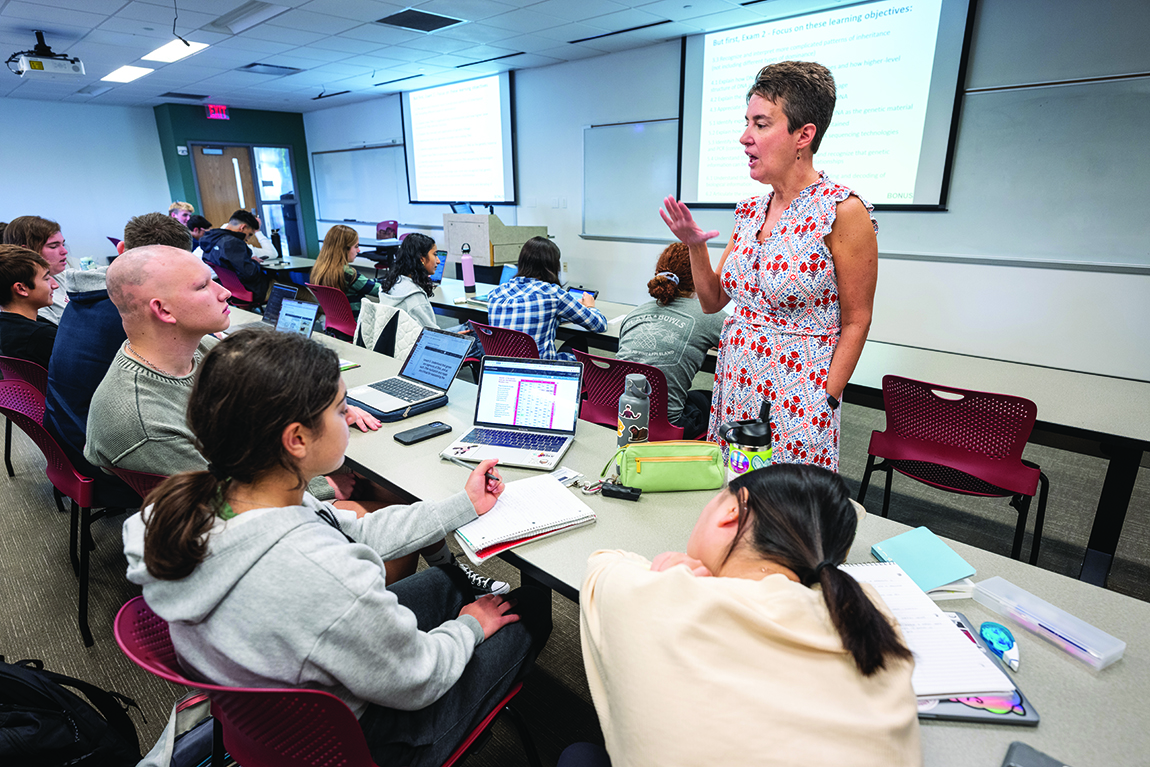Inside the Cell
Professor of Biology and Co-Director of Biochemistry Amy Hark shares her interest in genes and gene expression with students in the classroom, in her lab and via a research consortium she’s been part of since 2009.By: Meghan Kita Wednesday, November 16, 2022 01:56 PM
 Professor of Biology and Co-Director of Biochemistry Amy Hark with the plants used in her lab. Photos by Ryan Hulvat
Professor of Biology and Co-Director of Biochemistry Amy Hark with the plants used in her lab. Photos by Ryan HulvatProfessor of Biology and Co-Director of Biochemistry Amy Hark studies the regulation of gene function. If that sentence makes you want to close this tab, wait: She can explain what she does in terms that are approachable, even for the science-averse.
“Something that is important to me in my professional life is to be able to talk about science not only with people who identify as scientists but also with people who identify in other professional sectors or even as science-phobic,” she says. “Some of the best teaching experiences I’ve had have been with non-majors, some of whom are really scared to take college science classes.”
As an undergraduate at the College of William & Mary studying biology, she already knew that she eventually wanted to teach. She also found a home in a specific type of biology: “I figured out that what I liked was what I call ‘cells down,’ or anything smaller than a cell: What’s going on inside a cell that drives living systems?”

Here’s some of the story: Within a cell, the nucleus houses strands of DNA molecules called chromosomes. Each chromosome includes hundreds of shorter sequences called genes, each of which serves a purpose in the larger organism. Each gene can be switched on or off (expressed or not expressed), and its status can instruct the cell to do (or stop doing) certain things. For example, humans have a gene called P53 that, when activated, instructs cells to make a protein that puts the brakes on cell division. If a person has a DNA change that prevents P53 from being switched on, they can’t make that protein. Without it, cancerous tumors can grow unchecked.
But what switches genes on or off? As a Ph.D. student at Princeton University, Hark studied how a gene’s placement on a strand of DNA in relation to other genes might affect its expression. As a postdoctoral researcher at Michigan State University, she studied the relationship between how DNA is packaged within a cell and gene expression. In between, she took a sabbatical year to teach at Kalamazoo College in Michigan, an atypical move born out of her love for teaching.
“I liked being in a lab, but something I realized about myself during grad school is that I thrive and I do better when I’m doing multiple things,” Hark says. “So a hundred percent research, which is what most Ph.D. [programs] are like, was not the long-term goal for me. A hundred percent teaching wouldn’t have been the perfect fit either.”
She’s excelled at both at Muhlenberg, where she’s won the Lindback Foundation Award for Distinguished Teaching, the Paul C. Empie ’29 Memorial Award for Excellence in Teaching and the Bridge Builder’s Award, a recognition conferred by students who utilize the Academic Resource Center upon faculty who “have gone beyond expectations to promote an intellectually engaged, inclusive and supportive educational environment.” (She’s earned this award 19 times.) In her lab, she uses the model plant species Arabidopsis thaliana to conduct research similar to what she did as a postdoc, on how the packaging of the plant’s DNA affects gene expression. She and her students collaborate with Professor of Biology Elizabeth McCain, who uses scanning electron microscopy to determine what happens to these plants if their DNA packaging is disrupted.
Hark and McCain had just wrapped up a project when the pandemic began. Luckily, Hark’s lab had a second project going on, one that required only an internet connection to continue. Since 2009, Hark has been part of the Genomics Education Partnership (GEP), which was established in order to involve undergraduate students in genomics research. The GEP makes available raw data about genomes (the entirety of an organism’s genes) as well as computer-generated data about where within that genome specific genes might be. (“If we don’t know exactly where the gene is, it’s really hard to figure out its regulation,” Hark says.) Students then use that data to annotate the genome — describing exactly where specific genes are using multiple lines of evidence — a job that computers just can’t do precisely at this point.
“I’ve loved being part of this consortium, not only for the collaboration with faculty colleagues all across the country, but because my students have a sense that they’re part of a bigger enterprise,” Hark says.
The senior biochemistry and biology students in Hark’s capstone course, Genomes & Gene Evolution, have worked on GEP research as part of their classwork. Hark also teaches introductory biology and biochemistry courses. She says that teaching would be the hardest part of her professional life to give up because she loves the exchange of information that happens in the classroom, especially at a small, liberal arts institution.
“I love being in an environment where students are still seeking a broad education, but they’re also in this place of figuring out some of the things that excite them the most,” she says. “To be part of that and to get to know students and their trajectory, I mean … what a privilege to be part of that process.”
